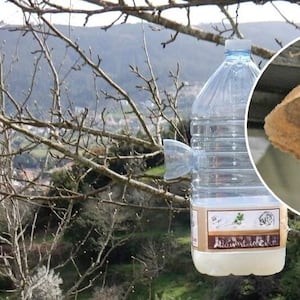World
New Zealand Intensifies Efforts Against Yellow-legged Hornet Threat

Biosecurity New Zealand has discovered a fourth yellow-legged hornet queen in Auckland, prompting the agency to implement trapping measures in its efforts to eliminate this invasive species. The latest queen was identified over the weekend in Birkdale, following the earlier detection of three queens in October in Glenfield, a suburb on the North Shore. Two of these queens were located within a 2-kilometer radius of the first, which has been actively constructing a nest.
The yellow-legged hornet, known for its predatory behavior towards bees, poses a significant threat to New Zealand’s primary industries. In response to the recent findings, the Ministry for Primary Industries (MPI) has announced plans to deploy traps specifically designed for capturing the hornets. This initiative aims to curb the population growth of this invasive species and protect the local ecosystem.
Brad Windust, a Northland biosecurity worker, has been vocal about the urgency of the situation. He has publicly criticized MPI’s response as “hopelessly inadequate,” emphasizing the potential dangers the hornets pose to New Zealand’s agricultural sector. Windust, a former beekeeper, has also reached out to Biosecurity New Zealand twice, urging the organization to acknowledge the severity of the threat.
Windust’s concerns extend to MPI’s previous statements regarding trapping methods. He challenged the assertion that no suitable traps exist for the yellow-legged hornets, advocating for more proactive measures to safeguard local bee populations and, by extension, the agricultural industry.
The presence of these hornets highlights the ongoing struggle between invasive species and native ecosystems. As Biosecurity New Zealand ramps up its efforts to combat this threat, the success of their strategies will be crucial in determining the future of local biodiversity and agricultural health. The situation remains dynamic, and ongoing monitoring will be essential as authorities respond to this emerging challenge.
-

 Sports2 months ago
Sports2 months agoNetball New Zealand Stands Down Dame Noeline Taurua for Series
-

 Entertainment2 months ago
Entertainment2 months agoTributes Pour In for Lachlan Rofe, Reality Star, Dead at 47
-

 Entertainment3 weeks ago
Entertainment3 weeks agoNew ‘Maverick’ Chaser Joins Beat the Chasers Season Finale
-

 Sports2 months ago
Sports2 months agoSilver Ferns Legend Laura Langman Criticizes Team’s Attitude
-

 Sports1 day ago
Sports1 day agoEli Katoa Rushed to Hospital After Sideline Incident During Match
-

 Politics1 month ago
Politics1 month agoNetball NZ Calls for Respect Amid Dame Taurua’s Standoff
-

 Entertainment2 months ago
Entertainment2 months agoKhloe Kardashian Embraces Innovative Stem Cell Therapy in Mexico
-

 World3 months ago
World3 months agoPolice Arrest Multiple Individuals During Funeral for Zain Taikato-Fox
-

 Sports3 months ago
Sports3 months agoGaël Monfils Set to Defend ASB Classic Title in January 2026
-

 Entertainment1 month ago
Entertainment1 month agoTyson Fury’s Daughter Venezuela Gets Engaged at Birthday Bash
-

 Sports1 month ago
Sports1 month agoHeather McMahan Steps Down as Ryder Cup Host After Controversy
-

 World2 weeks ago
World2 weeks agoSevere Winds Hit New Zealand, Over 100 Flights Canceled



















